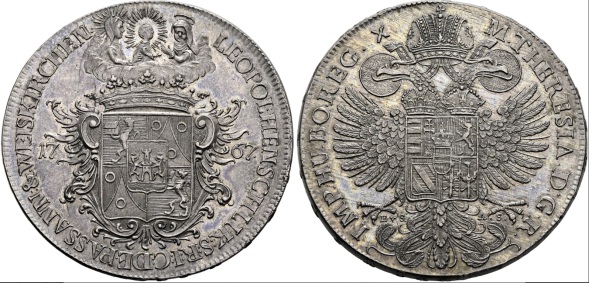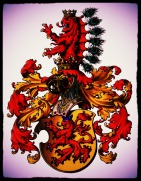Schlick
The rise of the Schlick family began in the first half of the 15th Century, when Kaspar Schlick, for his diplomatic services of the Emperor Sigismund to the Baron (1422) and Reich Counts (1437), was titled and given a patent for a coat of arms. Their area in addition included the counties of Bassano (Passaun) in Northern Italy and the Weisskirchen (Holíc) in today's western Slovakia, in addition to others. The source of their wealth was the silver mines at St. Joachimsthal and minting of coins (Joachimstaler, the first dollar size silver coin). After the silver discoveries at the beginning of the 16th Century they had the royal right to mint coins. The Bohemian crown usurped the family's right to mint coins in 1528. That right was returned in 1626. It was finally lost for good in 1806 when the whole region was absorbed by Napoleon, although the last official coins had been minted decades prior.
The noble family played an important role in the Czech corporate state in the first century of the Habsburg reign. They occupied important positions in the estate's management or were officers of the
Habsburg rulers. In the early 1520's numerous members sympathized with the Lutheran Reformation, while others remained Catholic. Major representatives of the family stood for the right of the stands
against the rulers of one. They took an active part in the uprisings against the Habsburgs in 1547 and 1618-1620. After the Battle of White Mountain they lost their assets, which were confiscated by
the emperor. One of the leaders of the Bohemian insurgents, Joachim Andreas von Schlick, was executed in 1621. The part of the family that remained faithful to the Habsburgs received a portion of the
estates of Messrs. Waldstein.
The Counts of Schlick (czech Šlikové) were originally a patrician family with roots in Bohemia and in Germany. The rise of the family began in the first half of the 15th Century, when Kaspar Schlick, for his diplomatic services of the Emperor Sigismund to the Baron (1422) and Reich Counts (1437), was titled and given a patent for a coat of arms. Their area in addition included the counties of Bassano (Passaun) in Northern Italy and the Weisskirchen (Holíc) in today's western Slovakia, in addition to others. The source of their wealth was the silver mines at St. Joachimsthal and minting of coins (Joachimstaler, the first dollar size silver coin). After the silver discoveries at the beginning of the 16th Century they had the royal right to mint coins. The Bohemian crown usurped the family's right to mint coins in 1528. That right was returned in 1626. It was finally lost for good in 1806 when the whole region was absorbed by Napoleon, although the last official coins had been minted decades prior. The noble family played an important role in the Czech corporate state in the first century of the Habsburg reign. They occupied important positions in the estate's management or were officers of the Habsburg rulers. In the early 1520's numerous members sympathized with the Lutheran Reformation, while others remained Catholic. Major representatives of the family stood for the right of the stands against the rulers of one. They took an active part in the uprisings against the Habsburgs in 1547 and 1618-1620. After the Battle of White Mountain they lost their assets, which were confiscated by the emperor. One of the leaders of the Bohemian insurgents, Joachim Andreas von Schlick, was executed in 1621. The part of the family that remained faithful to the Habsburgs received a portion of the estates of Messrs. Waldstein.
The First Silver Type Given the "Taler" Name. Struck at the Joachimsthal Mint Located in Present-Day Czech Republic
AUSTRIA. Schlick. Taler, ND (1505-26). Joachimsthal Mint. Stephan, Burian, Heinrich, Hieronymous & Lorenz. Dav-8138. Obverse: St. Joachim; Reverse: Rampant Bohemian lion. Stunning condition
for this first Taler type, this coin was struck on a planchet of good quality with bold and even detailing appearing throughout the designs. Carefully handled for ages, the surfaces now display
medium brown coloration with appealing blue and gold accents around the accentuated legends. Upon close inspection, no marks or major distractions appear, making the quality
undeniably RARE for the issue. Considering its appearance and historical importance, as well as its finest graded status at PCGS and NGC, a coin that could quite easily shoot past its given
estimate range. PCGS AU-55.
The Counts of Schlick owned the mine at Joachimsthal and struck coins from the silver mined there which were soon nicknamed "thalers". This type was struck in the name of Lajos II of Hungary and
Bohemia ("LVDOVICVS:PRIM:D:GRACIA:R:BO:"). His death at the hands of the Turks in 1526 allowed the Hapsburgs to seize Bohemia and confiscate the mines.
1526. Schlick. Stephan, Burian, Heinrich, Hieronymous & Lorenz Joachimsthaler. Joachimsthal mint, Dav-8146, Donebauer-3770. The mines of Bohemia were a major source of silver in the 16th
century. Coined at the Joachimstal mint, this type, of somewhat reduced weight and fineness from the Guldengroschen, became known as the Joachimsthaler, which was eventually shorten to "taler", a
term which later became "dollar". Almost fully struck, with most of its original mint bloom preserved, this stunning specimen retains a mint-fresh appearance that is wholly uncommon for this rare
issue. The finest of the early Schlick Talers that we have seen, and a superb lustrous survivor considering its nearly 400-year age. NGC MS-64.
Ex. Grundy Collection (Heritage Auction #3004, January 2009, Lot 20223)
1647/6 . Bohemia. Count Schlick, Heinrich IV., 1612-1650 Taler 43 mm Dav. 3408. Obv .: HENRICVS · SCHLI - CK: COMES: A: PASSAN Saint Anna Selbdritt appears above the Schlick coat of arms. She holds the young Mary in her left arm and the baby Jesus in her right arm. Rev: Title Ks. Ferdinand III. and a crowned double-headed eagle with a Bohemian breastplate. NGC MS-62.







